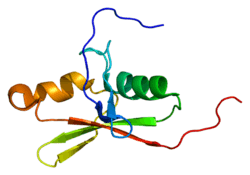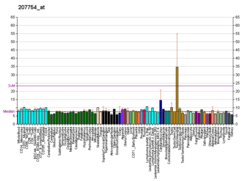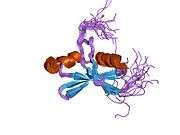RASSF8
Ras association domain-containing protein 8 is a protein that in humans is encoded by the RASSF8 gene.[5]
| RASSF8 | |||||||||||||||||||||||||
|---|---|---|---|---|---|---|---|---|---|---|---|---|---|---|---|---|---|---|---|---|---|---|---|---|---|
 | |||||||||||||||||||||||||
| |||||||||||||||||||||||||
| Identifiers | |||||||||||||||||||||||||
| Aliases | RASSF8, C12orf2, HOJ1, Ras association domain family member 8 | ||||||||||||||||||||||||
| External IDs | OMIM: 608231 MGI: 1918573 HomoloGene: 5219 GeneCards: RASSF8 | ||||||||||||||||||||||||
| |||||||||||||||||||||||||
| |||||||||||||||||||||||||
| |||||||||||||||||||||||||
| Orthologs | |||||||||||||||||||||||||
| Species | Human | Mouse | |||||||||||||||||||||||
| Entrez | |||||||||||||||||||||||||
| Ensembl | |||||||||||||||||||||||||
| UniProt | |||||||||||||||||||||||||
| RefSeq (mRNA) | |||||||||||||||||||||||||
| RefSeq (protein) | |||||||||||||||||||||||||
| Location (UCSC) | Chr 12: 25.96 – 26.08 Mb | Chr 6: 145.75 – 145.82 Mb | |||||||||||||||||||||||
| PubMed search | [3] | [4] | |||||||||||||||||||||||
| Wikidata | |||||||||||||||||||||||||
| |||||||||||||||||||||||||
References
- GRCh38: Ensembl release 89: ENSG00000123094 - Ensembl, May 2017
- GRCm38: Ensembl release 89: ENSMUSG00000030259 - Ensembl, May 2017
- "Human PubMed Reference:". National Center for Biotechnology Information, U.S. National Library of Medicine.
- "Mouse PubMed Reference:". National Center for Biotechnology Information, U.S. National Library of Medicine.
- "Entrez Gene: RASSF8 Ras association (RalGDS/AF-6) domain family 8".
Further reading
- Falvella FS, Spinola M, Manenti G, et al. (2007). "Common polymorphisms in D12S1034 flanking genes RASSF8 and BHLHB3 are not associated with lung adenocarcinoma risk". Lung Cancer. 56 (1): 1–7. doi:10.1016/j.lungcan.2006.11.008. PMID 17194498.
- Falvella FS, Manenti G, Spinola M, et al. (2006). "Identification of RASSF8 as a candidate lung tumor suppressor gene". Oncogene. 25 (28): 3934–3938. doi:10.1038/sj.onc.1209422. PMID 16462760.
- Rual JF, Venkatesan K, Hao T, et al. (2005). "Towards a proteome-scale map of the human protein-protein interaction network". Nature. 437 (7062): 1173–1178. doi:10.1038/nature04209. PMID 16189514.
- Gerhard DS, Wagner L, Feingold EA, et al. (2004). "The status, quality, and expansion of the NIH full-length cDNA project: the Mammalian Gene Collection (MGC)". Genome Res. 14 (10B): 2121–2127. doi:10.1101/gr.2596504. PMC 528928. PMID 15489334.
- Jin J, Smith FD, Stark C, et al. (2004). "Proteomic, functional, and domain-based analysis of in vivo 14-3-3 binding proteins involved in cytoskeletal regulation and cellular organization". Curr. Biol. 14 (16): 1436–1450. doi:10.1016/j.cub.2004.07.051. PMID 15324660.
- Strausberg RL, Feingold EA, Grouse LH, et al. (2003). "Generation and initial analysis of more than 15,000 full-length human and mouse cDNA sequences". Proc. Natl. Acad. Sci. U.S.A. 99 (26): 16899–16903. doi:10.1073/pnas.242603899. PMC 139241. PMID 12477932.
- Debeer P, Schoenmakers EF, Twal WO, et al. (2002). "The fibulin-1 gene (FBLN1) is disrupted in a t(12;22) associated with a complex type of synpolydactyly". J. Med. Genet. 39 (2): 98–104. doi:10.1136/jmg.39.2.98. PMC 1735038. PMID 11836357.
- Debeer P, Schoenmakers EF, Thoelen R, et al. (2000). "Physical map of a 1.5 mb region on 12p11.2 harbouring a synpolydactyly associated chromosomal breakpoint". Eur. J. Hum. Genet. 8 (8): 561–570. doi:10.1038/sj.ejhg.5200497. PMID 10951517.
This article is issued from Wikipedia. The text is licensed under Creative Commons - Attribution - Sharealike. Additional terms may apply for the media files.





